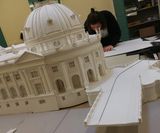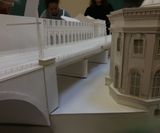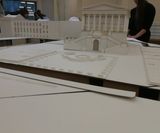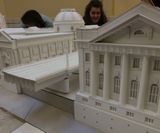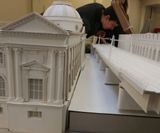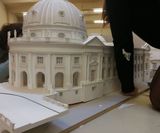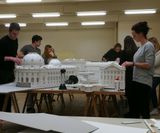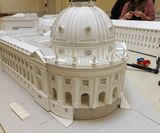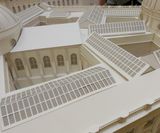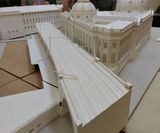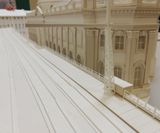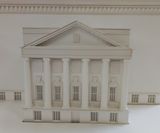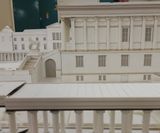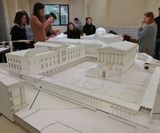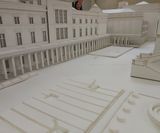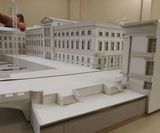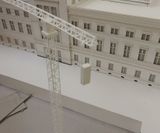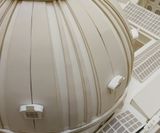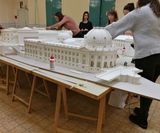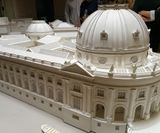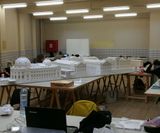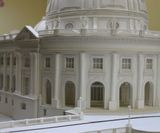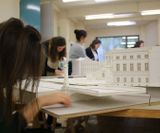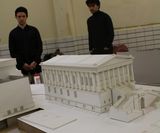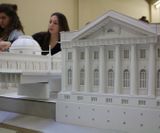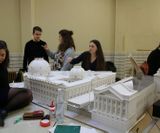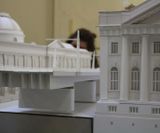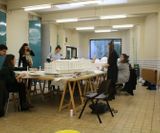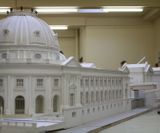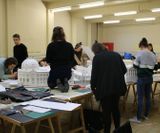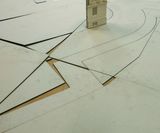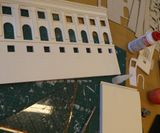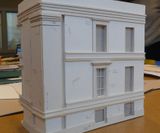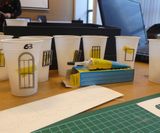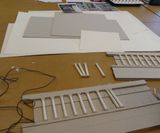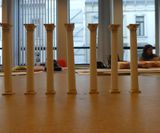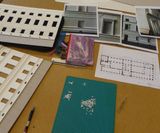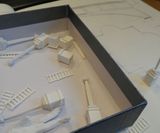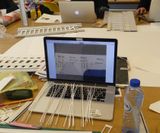Studio Anatomy
GÖTTERDÄMMERUNG?
A MORATORIUM ON BEING.HUMAN.BODY.ARCHITECTURE?
Site: Museuminsel, Berlin (DE)
2017-2018
Partner of the Wandering Arts Biennial 2018, Brussels (BE)
Introduction
Studio Anatomy (Academic Design Office) connects research in/on architecture with architectural education and architectural practice. Through the vertical section, an act of cutting, Studio Anatomy traces socio-historical layers, starting from the topography (i.e. geology, the vertical section) and stretching as far as the full scale architectural (constructive) detail (i.e. the section, again). This cutting aims to interrogate connections between poetics (the deeply personal, the subjective and the emotionally loaded in architecture) with technics (its materialization, construction practice) by intensely interweaving both in the research process from the very beginning, hence covering the full stretch from poetics to technics in architecture in order to produce an architecture that is humanly more complete.
Studio Anatomy looks at architecture beyond its outer appearance, beneath the skin, and critically questions the too speedy nature at the surface of the things we see (in architecture)—the superficiality of the world—by cutting into and under the skin of things (architecture). Alberto Pérez-Gòmez suggests that the section is of a foremost importance in the architect’s work, as a prediction on the casting of shadows, pointing at the anatomic nature of the section that, applied by the architect, “break[s] the skin of things in order to show” (Pérez-Gòmez 2006), completing his argument with Merleau-Ponty, “how the things become things, how the world becomes a world” (Merleau-Ponty 1964). This cutting into substance is resistant, hence it slows down our acting and intensifies our thinking. Slowing instead of speeding. Because slowing permits one to perceive, absorb and embody longer, better, deeper, so as to discover the depth of architecture. Depth is the first, not the third dimension in architecture (Van Den Berghe 2012), hence in Studio Anatomy. Designing and thinking in Studio Anatomy also starts from the strong presence of substance and bodily experience (Pallasmaa 2009). This cutting implies that the architecture under investigation is being anatomised and better understood, and by doing so, new embodied knowledge emerges.
This research operates in the Museumsinsel in Berlin, in the area north of the Bodestraße, and stretching as far as the Bodemuseum at the north end of the island.
Our decision to return to Berlin for this research, and more specifically to the Museumsinsel, encapsulates the city being heavily loaded—historically, culturally—a legacy that this part of the city seems to express compellingly through its architectural bodies and spaces that also seem to tease out connections with the actual political and cultural climate.
Ai Weiwei (Weiwei 2018), who lives and works in Berlin, states that Western (European) Democracies apparently rely on the self-evident presence of Democracy and Human Rights, which they seem to take for granted all too arrogantly, thinking these values and structures are indestructible. However, Weiwei’s contention clearly holds a warning, based on his personal experiences and his observations all around the globe. To some extent, all of us may share these experiences and observations from the 20th Century and from more recent history. Finding Democracy under threat and comparing this with its historical precedents, certainly in Berlin, one might witness another imminent Götterdämmerung.
Objectives / Studio Assignment
By means of wandering along limits (Sanders 2017)(Eisenstein 1938)(historical, constructive, political, cultural, …), points of (p)reference in the architectural topography of the Museumsinsel have to be identified and located. The plans and observations of Roma by Nolli (1748) and Piranesi (ca. 1774), as well as Roma Interrotta (Sartogo 1978)(Delbeke 2011), are the main references of this assignment. Isn’t Berlin another interrupted city?
These points of (p)reference clearly constitute ‘a place’, into which a suite of rooms has to be designed as a new pavilion within the site. This suite of rooms constitutes an antichambre, a chambre, and finally—and only for those who want to make an effort by approaching, going through transitions between ‘out’ and ‘in’, from room to room and through the meticulously designed transitions between these rooms—the desired moratorium space (the third room) as a celebration for Being.Human.Body.Architecture can be discovered. It would be wrong to insert this pavilion as an isolated ‘object’ onto the site. Rather, the newly designed architectural body should be inserted into the site (Moravánsky 2005) by intimately engaging with, or coming forth from, or penetrating into, or growing out of, one of the existing architectural bodies. A special interest for the historical presence of the site should raise questions such as: how to engage, as an architect, with a loaded architectural history of a place, when intervening architecturally in this place today?
Drawing constitutes the core of the method of Studio Anatomy for researching and making body and space in architecture. We have called it Critical Sequential Drawing (CSD)(see below), and it continuously resonates with in depth reflections on construction practice, art, structural engineering, architectural history and theory.
Hence these investigations have to be done through discipline specific actions and procedures of drawings and scale models that may start from the scale of the fragment (1/50, 1/10), from where the design actions try to grasp the scale of the whole (1/100, 1/50, 1/20) and to reach the scale of the architectural detail (1/10, 1/1).
The drawing processes will
(1) start from the vertical section that occurs by ‘omitting the fourth wall’ and
(2) that becomes the first framing (cadrage) like one discovers in the
(3) perspective method in the painting Flagellazione (Piero della Francesca 1455-1460). This cadrage is the starting point for an in-depth research of the potential of the window and the act of looking (station point, eye level, vanishing point), and going as far as the full scale architectural (window) detail (Friedberg 2006).
By means of sequentially drawing vertical sections—into which central perspective drawings have to be developed—the student/draughts(wo)man draws himself/herself a way into the transitions and spaces of the Chambre, Antichambre and finally the Moratorium Space.
These drawings are being made, sent through a cyclical process that includes (1) drawing a version, (2) critical (self) assessment of that version, (3) verbalisation through peer discussions, and (4) repeated through new versions that are sent through a similar process so as to generate a process of Critical Sequential Drawing 2(CSD). CSD permits for comparative studies of ‘versions’.
By drawing, the student wanders from space to space in a slow pace, intensively absorbing and drawing every detail of each room, and specifically the transitions between these rooms. Hence, this wandering is a process of slowing, inasmuch as it both takes moving physically and coming to a standstill in order to deeply observe and absorb. The draughts(wo)man dwells between flux and stasis and flux.
The genesis of these rooms includes the study of meaningful references (section, plan, detail), and making a record of these studies, face to face with the identified point of (p)reference in the site (cfr. ATLAS).
Hence, closely looking through the design of spatial transitions, this investigation inevitably will also have to confront making (an) incision(s) into an architectural body, its mass of brick or stone—which inevitably includes creative structural interventions and the full scale technical (door/window) detail(s)—as key research themes.
Next to drawing as the key element of the research method, these investigations also include all the other media at hand (film, photography, 3D-modeling, …) which can add to the insights, clarification and communicability of the anatomy of Moratorium Space in architecture. The investigation of the whole, the fragment and the detail will focus on the structural and technical aspects of the envisaged interventions which in their turn have to be situated in the context of architectural history, the arts, and science through rigorous referencing (author, year, title, editor, place) that has to be incorporated in the course and the final output of this research through images and/or text (cfr the ATLAS).
1. The exiled Chinese conceptual artist Ai Weiwei has created this year with his film Human Flow (2018) an ambitious, humane and often shocking cine-essay on the subject of migrants and the 21st century migrant condition.
2. Critical as a method of constant and critical (self) assessment in and during the drawing session itself, sequential as a cyclical and repetitive process of drawing new versions in order to draw a better version of the previous one after the (self) assessment. It is a method of constant improvement in the way Ranulph Glanville describes it in his paper Doing the Right Thing: the Problems of … Gerard de Zeeuw, Academic Guerilla (Glanville 2002), where Glanville elaborates on de Zeeuw’s concept of improvement: how to turn observations into high quality observations by turning these observations, in a second round of observation, into an observable in its own right, so as to go for improved observations that generate improvement of action.
